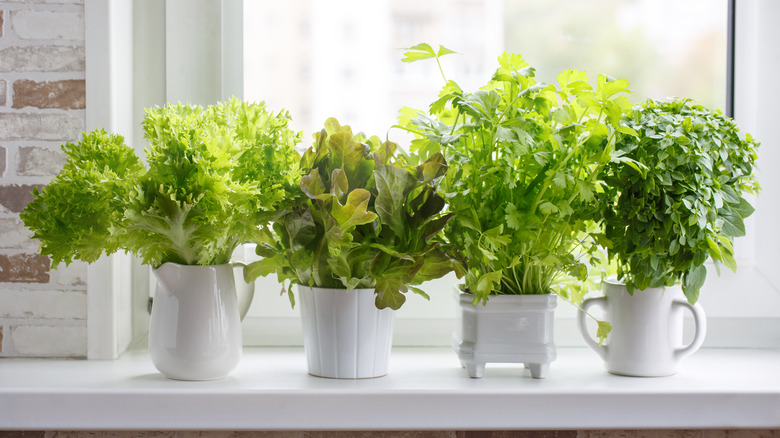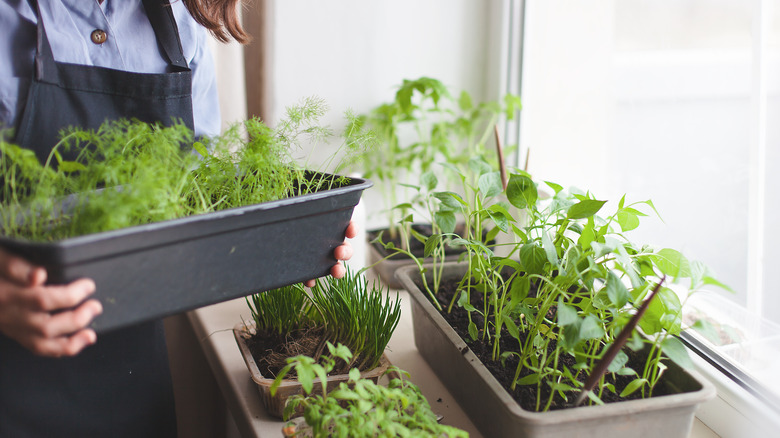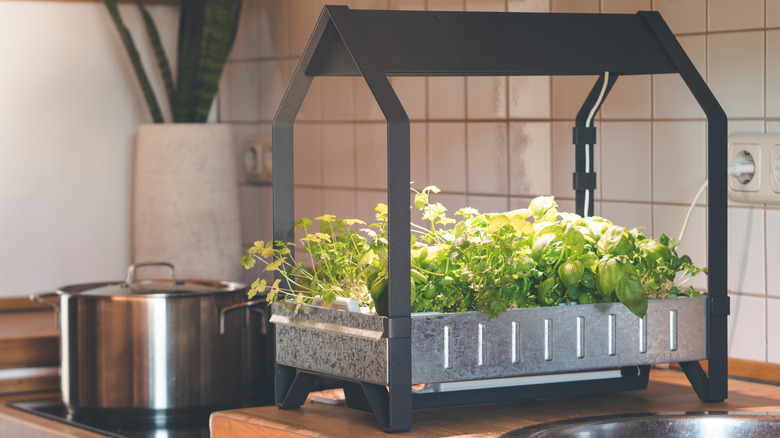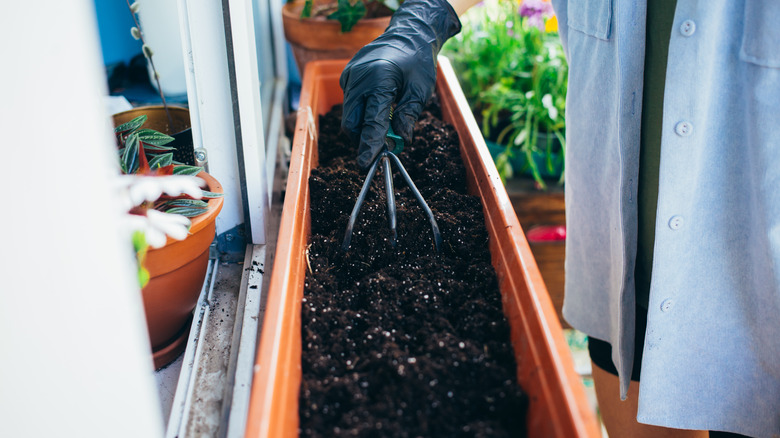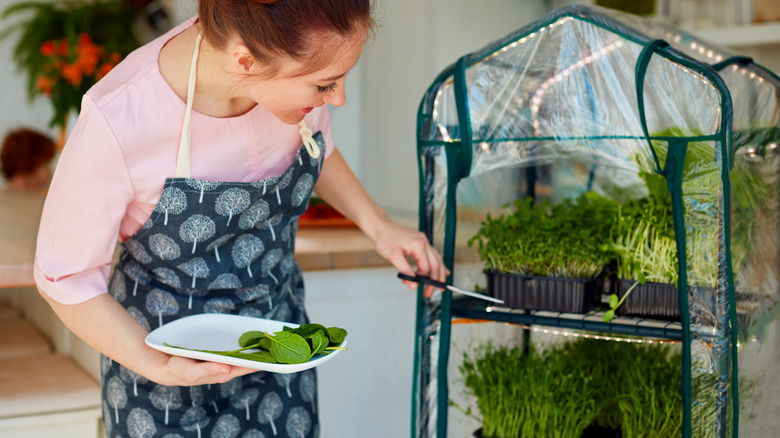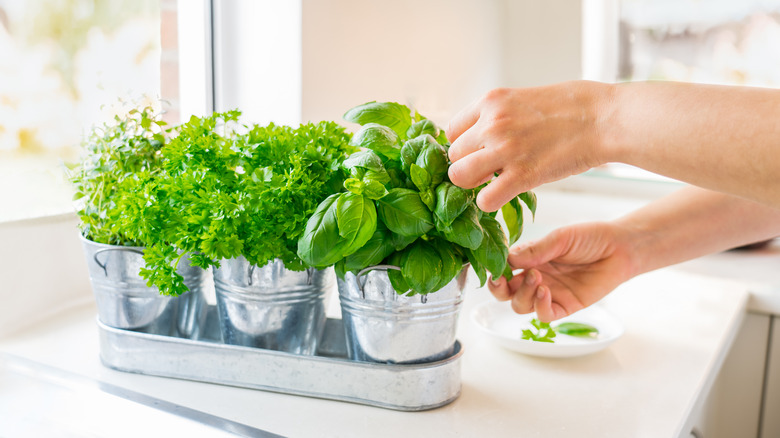How To Grow A Small Herb Garden In A Tiny Kitchen
Not sure if you want to grow an herb garden yet? Even the tiniest kitchens can find space for a couple of plants and tasting the fresh flavor of herbs harvested moments before you use them if your cooking is convincing enough to grow your own small garden. Utilizing your herb garden will make your food taste way better than if you purchased them from the grocery store. Plus, you can dry them and make your own spices if you have an abundance of harvest. Gardenary explains that many herbs are low-maintenance, so once you find a spot with some sun, all you have to remember is to water them and occasionally add fertilizer.
You can choose to grow your herbs from seed or purchase a seedling. The latter will allow you to start harvesting them sooner. Also, it doesn't matter how small your kitchen is because these plants will happily grow in any amount of space you give them. Depending on which herbs are best for your kitchen, you can even plant some in the same pot.
Companion plant
Companion planting will help you save space in a tiny kitchen and keep the soil nutritious for better-tasting herbs. When you group certain plants and put them in the same pot, they will benefit each other differently. Herbs at Home also explains that some herbs, like basil, have properties that repel pests. This makes them a great addition to prevent your garden from an infestation.
Choosing which herbs to plant in one pot depends on their light, water, and container requirements. You don't want to put a plant that needs bright, direct light with one that needs shade because they won't be able to thrive in the same location. The same goes for the amount of water they need; since they're sharing soil, you can't keep it half moist and half dry. Harper's Nurseries recommends grouping basil, oregano, parsley, and chamomile. Another combination that works well is sage, thyme, rosemary, and oregano. However, you can customize what plants you grow together as long as they have the same requirements.
Supplement with grow lights
In tiny kitchens, you have to work with limited counter space and possibly only one window. My Almost Green Thumb explains that herbs need a lot of light to develop their flavor; however, you may not have enough room on your windowsill for bulky pots. One way to remedy this is with grow lights. You can even use these special bulbs as the only light source for your plants. Incorporating these in the setup allows you to move your herb garden anywhere. On the other hand, maybe you're tight on space and only have room under your counter. In that case, you would mount these lights underneath the counter and place your herbs below them.
When looking at grow lights, you should choose one that is full spectrum. This means that it has blue and red or ultraviolet and infrared light. Plants need a full range of colors to grow and photosynthesize. That said, LED bulbs are preferred because they are energy efficient and don't produce much heat. When placing your grow bulbs, you should put them over your plants if they are the only light source or on an angle if they are supplemental. Depending on the type of bulb you choose, it should be at a safe distance from your herbs to prevent them from burning: LEDs should be placed 6 inches from the top of the plant, incandescent should be 24 inches away, and fluorescent should be 12 inches above the planter.
Choose the proper container
An herb garden is perfect for small kitchens because most plants don't need much space to grow; however, the type of container you put them in matters more than you may think. It will affect the space you have in your kitchen and how quickly the soil dries. According to Herbs at Home, most herbs have shallow root systems, so an 8- to 10-inch pot is plenty of room. In addition, herbs are known for growing to the size of their container, so they will keep getting bigger if you continue to repot them.
When looking at which pots to use, you should pay attention to what they're made of. The primary materials available are plastic, terracotta, and glazed ceramic. These mediums will affect your herbs' soil differently. Plastic and glazed ceramic will trap water in and is best for plants that prefer moist soil, like rosemary, sage, or thyme. On the other hand, the difference between the other two pots is mainly aesthetic. Terracotta is an unglazed ceramic and will dry out the soil because it has porous clay walls. This material also allows more air to flow around the roots. Herbs like mint, parsley, or oregano prefer this pot. Glazed ceramic pots are mainly used for aesthetic purposes but tend to be heavier. Still, no matter the planter you choose, it should have at least one hole at the bottom to drain extra water.
Use vertical space
If you don't have a lot of open counter space in your kitchen, you can still have a thriving herb garden. One spot that is often overlooked is the walls, so using the empty vertical space for a garden will benefit your home in many ways. There are commercially available garden systems that you can purchase or structures you can build your own, and because there are so many different options, you don't have to sacrifice your kitchen décor. Garden Tabs explains that these garden systems range from simple wall-mounted shelves to decorative hanging planters.
Using the vertical space available in your kitchen will save your countertops for food prep. It also can make a small room appear larger than it truly is. When you put something on a wall, especially if it is tall enough to be high, it draws the eyes upward (via The Low Down), so taking advantage of this vertical space will elongate the height of the room. As a result, the kitchen will feel more open and larger.
Harvest your herbs
Harvesting your herbs is essential to keep them from overgrowing. Once summer arrives, take advantage of your fast-growing plants and snip off the leaves to use in your kitchen. This time of year is the best time to harvest because your plants will have the most flavor, according to Savvy Gardening. You can choose to take what you need while cooking for super fresh herbs or prune them down and dry them to use all year round.
To maintain your garden, you should never trim more than ⅓ of the plant at one time. If you start with seedlings, you can begin harvesting once they are about 6 to 8 inches tall. There are multiple ways to take the leaves off of your plants, and one common way that requires no extra tools is to pinch the new growth off with your fingers. This method works best with young tender herbs. Use herb snips or garden shears if your plants are woodier or have thick stems. Regularly trimming them will also promote new growth and branching. To ensure this, cut off a few sets of leaves between the nodes on the stem.
